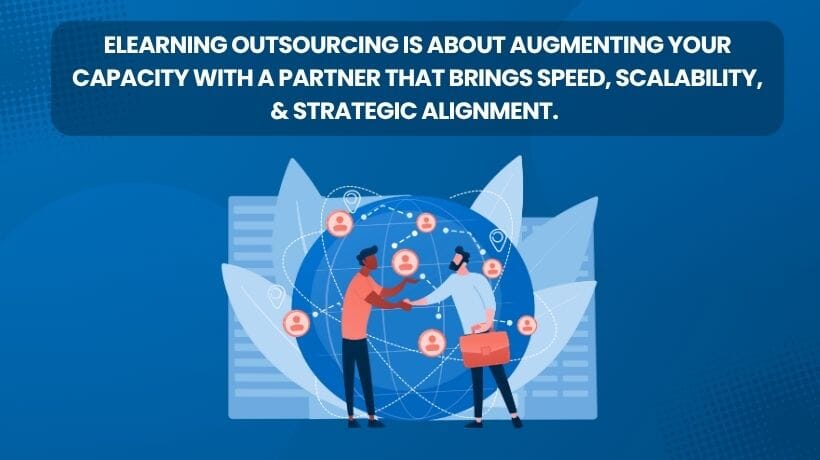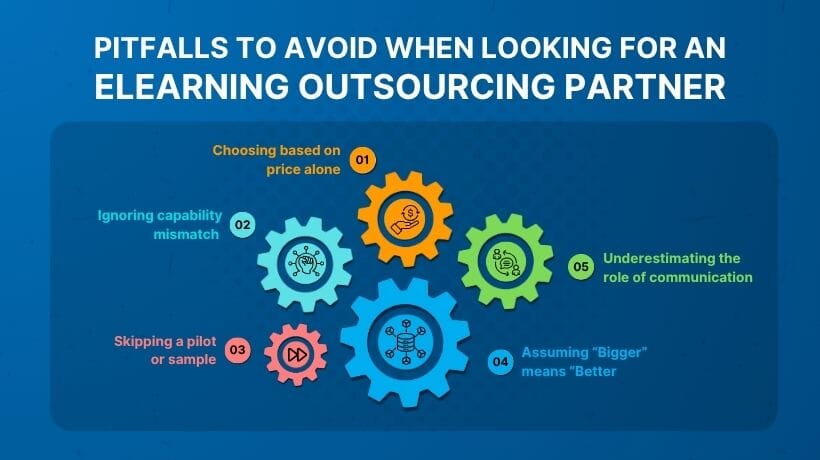eLearning Outsourcing: An L&D Manager's Guide
In today's high-velocity business environment, eLearning is a strategic enabler. But designing, developing, and scaling digital learning content in-house can stretch even the best Learning and Development (L&D) teams. eLearning outsourcing becomes not just a cost play, but a necessity for agility, speed, and access to expertise. Yet, the decision to outsource eLearning is only half the equation. The real challenge is choosing the right outsourcing partner.
After being a valuable partner to more than 300 global companies, let me share with you how L&D leaders can navigate this high-stakes decision, using real-world experiences and hard-won lessons from global enterprises.
The Decision To Outsource: It's Not Just About Capacity
When a Fortune 500 manufacturing company decided to digitize its instructor-led product training, it wasn't because its L&D team lacked talent. It was because it lacked scale. Its internal team of six could manage onboarding or compliance, but creating 20+ modules in six languages in three months was a different ballgame.
They turned to CommLab India for help. The outcome? A full curriculum of translated, media-rich modules rolled out across five regions and delivered 40% faster than their internal estimate.
Outsourcing isn't about replacing your team. It's about augmenting your capacity with a partner that brings speed, scalability, and strategic alignment.

Image by CommLab India
What Really Matters In An Outsourcing Partner?
Let's break it down into 5 critical dimensions that L&D leaders often overlook...until it's too late.
1. Expertise In Adult Learning, Not Just Content Development
Many vendors can animate slides or build flashy interactions. But true learning impact comes from understanding how adults learn, especially in high-stakes environments such as sales enablement or technical training.
A seasoned partner brings Instructional Designers who don't just "convert" content but transform it. They question assumptions, tighten bloated content, and design for performance, not seat time.
Real-world example: A logistics company outsourced SOP training to a vendor that produced beautiful animations, but missed critical compliance steps. The training had to be scrapped. They later partnered with an ID-led team that worked directly with Subject Matter Experts (SMEs) to validate content accuracy, reducing legal risk and rework.
2. Speed And Scalability Without Compromising Quality
You're probably under pressure to launch training before the product does. Your outsourcing partner should operate at your speed, not the other way around. This means:
- Rapid prototyping in days, not weeks
- Agile reviews with SMEs
- Parallel production pipelines for global rollouts
What to ask: "What's your turnaround time for a 30-minute module from storyboard to delivery, assuming SME availability?" If the answer isn't less than three weeks, keep looking.
3. Multilingual And Multi-Format Capability
Today's learners are global, mobile, and short on time. Your eLearning outsourcing partner should support:
- eLearning content translation and localization into multiple languages, with cultural nuance
- Formats beyond SCORM, such as microlearning, mobile learning, video explainers, and simulations
Real-world example: A German automotive client needed technical training translated into 12 languages, including voiceover sync and on-screen text. We used a blend of AI-enabled translation (Smartcat) and native-language reviewers, delivering 25% faster than conventional workflows.
4. Process Maturity And Transparent Communication
eLearning outsourcing can quickly become frustrating without process clarity. Look for partners who:
- Use project charters, clear SLAs, and milestone plans
- Offer dedicated project managers
- Use modern tools (Asana, Jira, etc.) for tracking and updates
Beware of partners who say yes to everything. The best ones challenge you—with respect and rationale. They proactively flag risks, offer options, and co-own your outcomes.

Image by CommLab India
Tip: Ask for a walkthrough of their project tracking system. You'll learn more in five minutes than from a 50-page proposal.
5. Cultural Fit And Partnership Mindset
This is the most underappreciated and most decisive factor.
You don't need a vendor. You need a thinking partner who understands your business, challenges your assumptions, and grows with you. Someone who's as invested in your learner outcomes as you are.
Litmus test: If your partner's first question is "Where's the storyboard?" instead of "What business goal are we trying to solve?", you're dealing with a vendor, not a partner.
Common Pitfalls To Avoid When Looking For An eLearning Outsourcing Partner
Outsourcing eLearning design and development can save you time and resources, but only if you sidestep the following traps.
1. Choosing Based On Price Alone
Cost is important, but training is a long-term investment. A cut-rate vendor may compromise instructional integrity, design quality, or project communication, resulting in rework, learner confusion, or reputational damage.
2. Ignoring Capability Mismatch
A vendor may be great at compliance training but fail at technical content or software simulation. Ensure they have domain-specific experience, not just general expertise.
3. Skipping A Pilot Or Sample
Would you buy a car without a test drive? Request a paid pilot or sample output. It's the fastest way to assess alignment on quality, speed, and process.
4. Assuming "Bigger" Means "Better"
Large firms often assign junior resources to smaller accounts. Mid-sized, focused teams often provide better ownership, responsiveness, and continuity.
5. Underestimating The Role Of Communication
L&D projects are collaborative. A lack of clarity in updates, versioning, or scope changes can derail your timeline. Choose partners who over-communicate, not under.

Image by CommLab India
What A Great Outsourcing Partner Looks Like
Here's your high-performance checklist:
- Instructional Designers who understand business outcomes
- Project managers who speak "L&D" and manage timelines with precision
- Translators who localize, not just translate
- Visual designers who follow accessibility and UX best practices
- Technologists who know LMS integrations, xAPI, AI tools, and formats
- Consultants who bring ideas to the table, not just labor
- A culture of accountability, respect, and co-creation
So, how do you select the right eLearning vendor?
Bonus: Ask if the partner offers value-added services such as AI-enabled translation, learner analytics dashboards, or post-rollout reinforcement. These are signs of a forward-thinking team.
Smart Questions To Ask A Potential Vendor
Use these questions to dig deeper during your evaluation process.
Capability And Experience
- What industries or types of training do you specialize in?
- Can you share a portfolio of technical or compliance courses?
- How do you ensure content accuracy when working with SMEs?
Process And Timelines
- What is your typical turnaround time for a 30-minute custom eLearning module?
- How do you manage change requests or scope creep?
- What tools do you use for project tracking and collaboration?
Localization
- How do you manage translation and voiceover across multiple languages?
- Can you handle cultural adaptation, not just literal translation?
Quality And Outcomes
- How do you ensure instructional soundness and learner engagement?
- What’s your approach to accessibility (WCAG compliance)?
- Do you offer data or learner analytics post-deployment?
Communication And Culture
- Will we have a dedicated account/project manager?
- How do you handle feedback cycles and SME delays?
- Can you work in our time zone for synchronous meetings?
Final Thought: Don't Just Delegate. Co-Create.
Outsourcing eLearning design and development doesn't mean handing off responsibility. It means selecting a partner who can work with you, shoulder to shoulder, to turn your vision into learning that drives real performance.








